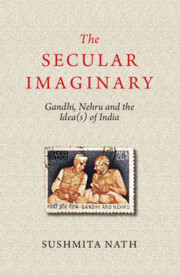Book contents
- Frontmatter
- Contents
- Preface
- Acknowledgements
- Introduction
- 1 Debating the Secular beyond the West
- 2 Gandhi’s Ashram and Political Thought: A Counter-narrative of Secularity
- 3 Gandhi’s Associationalism: A Non-state Alternative to Liberal Secularism?
- 4 Was Nehru Nehruvian? Religion, Secularity and Nehruism
- 5 Nehru and the Politics of Liberalism of Fear
- Conclusion
- Bibliography
- Index
2 - Gandhi’s Ashram and Political Thought: A Counter-narrative of Secularity
Published online by Cambridge University Press: 27 September 2022
- Frontmatter
- Contents
- Preface
- Acknowledgements
- Introduction
- 1 Debating the Secular beyond the West
- 2 Gandhi’s Ashram and Political Thought: A Counter-narrative of Secularity
- 3 Gandhi’s Associationalism: A Non-state Alternative to Liberal Secularism?
- 4 Was Nehru Nehruvian? Religion, Secularity and Nehruism
- 5 Nehru and the Politics of Liberalism of Fear
- Conclusion
- Bibliography
- Index
Summary
In South Africa, my best creation was Phoenix. Without it, there would have been no satyagraha in that country. Without the Ashram here, satyagraha will be impossible in India.... I am going to ask the country not to judge me by either Champaran or Kheda but only by the Ashram. If you find lack of order in this place, and blindness of ignorance, then you will find the same in all my work.... Do not attribute greatness to me for other works of mine; judge me only by the Ashram.
INTRODUCTION
Any scholar embarking on a study of Gandhi's thought must seriously consider Narayan Desai's view (himself a Gandhian and an ashramite) that Gandhi's life and thought are intertwined and inseparable, such that the spiritual or religious Gandhi is inseparable from the political one. Desai's opinion that ‘Gandhi cannot be properly understood in parts. He must be studied in totality’ reminds us that Gandhi embodied the message of truth and ahimsa (non-violence) by the way he lived his life. In his biography on Gandhi, Desai warns us of the ineluctable move to study and thereby create two diametrically opposed Gandhis – the idealist philosopher and the activist politician. Understanding Gandhi's thought thus poses an immense challenge if one wishes to simultaneously examine both the Gandhi that led the Indian masses to freedom from colonial rule and the Gandhi of spinning, fasting, celibacy and silence. As we know, Gandhi's politics brought together the divided elite politics of the Indian National Congress (hereafter, the Congress) and popular uprisings of the masses, particularly the rural peasantry, in the Indian subcontinent. His politics thus simultaneously sought to reach two audiences – the elite and the masses – through two separate registers of ‘communication and persuasion’. While Gandhi's writings – speeches, articles, books, interviews, and so on– attended to the elites, to the peasant, words when written appeared ‘a taking away of language rather than a giving’. Gandhi therefore resorted to the use of other elements in the complex and wide semiotic register available in rural India, which included ‘the symbolism of a whole range of non-discursive and non-modern ways of making meaning – from prayers to silences to dress to food, which for all their non-wordiness represented ideas and persuaded people by techniques that had been deployed for their persuasion for centuries’.
- Type
- Chapter
- Information
- The Secular ImaginaryGandhi, Nehru and the Idea(s) of India, pp. 47 - 97Publisher: Cambridge University PressPrint publication year: 2022



